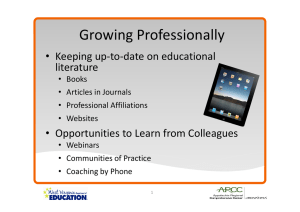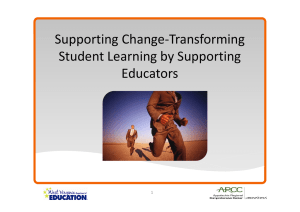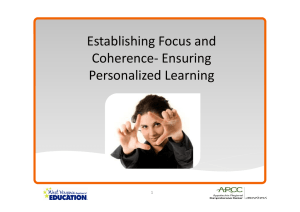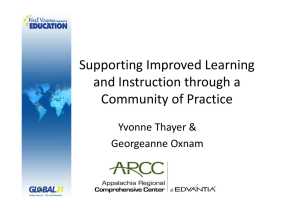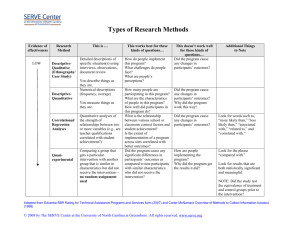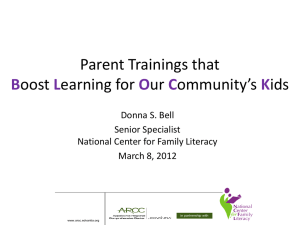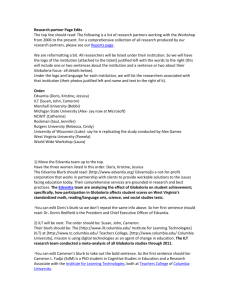Maximizing Capacity-Using Evidence to Collectively Personalize Student Learning 1
advertisement
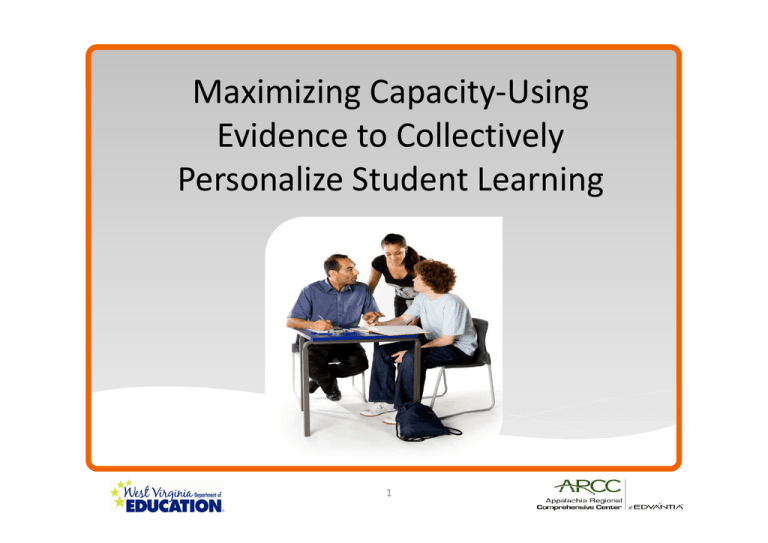
Maximizing Capacity-Using Evidence to Collectively Personalize Student Learning 1 A Coach Helps School Staff Members Improve… • Competency • Confidence • Commitment 2 Reflection How does a coach build the instructional capacity of individual teachers, teams, and schools? 3 Maximizing Capacity • Promoting data driven decision-making • Asking the right questions • Facilitating critical reflection, dialogue, and discussion 4 Data-Driven Decision Making “If schools are not getting the results they want, they need to consider their processes, or how they are getting their results. If they want different results, they must change the processes that create the results.” Bernhardt, 2004 5 Considering the Meaning of Data “The term data does not mean just test scores; it encompasses all the talk and work of teachers and students. Data may come from homework assignments, writing samples, portfolios, exit slips, journals, or any information that provides the opportunity to discuss student work in the context of the lesson and instruction.” Nidus and Sadder, 2011 6 Effective Questioning • Clarifying Questions gather additional information. • Eliciting Questions extend thinking. • Leading Questions encourage reflection. 7 Facilitating Critical Reflection, Dialogue, and Discussion “A committed listener helps people think more clearly, work through unresolved issues, and discover the solutions they have inside them. This often involves listening beyond what people are saying to the deeply held beliefs and assumptions that are shaping their actions.” Hargrove, 1999 8 Pace and Lead 1. Acknowledge the individual’s or group’s current state of mind. 2. Treat the state or experience as valid. 3. Match the state. 4. Gently lead the individual or group to the new, desired state. 9 Acknowledging the Current State of Mind • “You seem to be feeling anxious.” • “I’m sensing that you feel frustrated." • “I get the sense that you are overloaded.” • “It seems to me that you’re feeling confused.” 10 Treating the State of Mind or Experience as Valid • “This is not surprising.” • “You have every right to feel this way.“ • “This is a very normal feeling.” • “Many others are feeling this same way.” 11 Matching the State of Mind • “I’ve felt exactly the same way myself.” • “I’ve been there myself.” • “I’m having the same reaction.” • “I can empathize with you.” 12 Gently Leading to a New State of Mind • “I believe that when some of your questions are answered, you’ll feel more comfortable with this.” • “Let me tell you how I dealt with a similar situation.” • “Here are some strategies I’ve used to deal with this problem.” • “Tell me what’s bothering you. Perhaps I can clarify some points of concern.” 13 Pace and Lead From To Uninterested Resentful Stressed Overwhelmed Some interest Less annoyed Some comfort Seeing some possibilities Some potential Some clarity Powerless Confused 14 Pace and Lead • Acknowledge the current state of mind. • Treat the state of mind or experience as valid. • Match the state of mind. • Gently lead to a new state of mind. 15 Coaching Cycle Pre-observation Conference: Establish Focus Classroom Observation: Observe or Model Lesson Post-observation Conference: Debrief Lesson 16 Giving Feedback • • • • Descriptive Specific Well-timed Clearly communicated 17 Using Praise • Contingent • Specific • Sincere • Varied • Credible 18 References Bernhardt, V.L. (2004). Data analysis for continuous school improvement. Larchmont, NY: Eye on Education, Inc. Blanchard, K. (2007). Leading at a higher level: Blanchard on leadership and creating high performing organizations. Upper Saddle River, NJ: Prentice Hall. Block, P. (2000). Flawless consulting: A guide for getting your expertise used. San Francisco: Jossey-Bass/Pfeiffer. Carroll, T. (2009). The next generation of learning teams. Phi Delta Kappan, 91(2), 8-13. DuFour, R., DuFour, R., Eaker, R., and Many, T. (2010). Learning by doing: A handbook for professional learning communities at work. Bloomington, IN: Solution Tree. 19 References (continued) DuFour, R., & Eaker, R.(1998). Professional learning communities at work: Best Practices for Enhancing Student Achievement. Bloomington, IN: Solution Tree. Elmore, R. (2003).School reform from the inside out; Policy, practice, and performance. Boston: Harvard Education Press. Fullan, M. (2001). Leading in a culture of change. San Francisco, CA: Jossey Bass. Hargrove, R. (1999). Masterful coaching: Extraordinary results by impacting people and the way they think and work together. San Francisco: Jossey-Bass/Pfeiffer. 20 References (continued) Harvard University. (2003). The CLG concept of the change coach. Unpublished paper. Kaser, J.,Mundry, S., Stiles, K., & Loucks-Horsley, S. (2002), Leading every day. Thousand Oaks, CA: Corwin Press. Knight, Kim. (2011). What good coaches do. Educational Leadership, 69(2), 18-22. Lencioni, P. (2005). Overcoming the five dysfunctions of a team: A field guide for leaders, managers, and facilitators. San Francisco: Josey-Bass. Nidus, G., and Sadder, M. (2011). The principal as formative coach. Educational Leadership, 69(2), 30-35. 21 References (continued) Schmoker, M., (1999). Results: The key to continuous school improvement (2nd ed). Alexandria, Va: Association for Supervision and Curriculum Development. Senge, P. M., Kleiner, A., Roberts, C., Ross, R., Roth, G., & Smith, B. (1999). The dance of change: The challenges to sustaining momentum in learning organizations. New York: Doubleday. Speck, M. (1996, Spring). Best practice in professional development for sustained educational change. ERS Spectrum, 33-41. 22 The Appalachia Regional Comprehensive Center (ARCC) at Edvantia is one of 21 technical assistance centers funded by the U.S. Department of Education (16 regional centers and 5 content centers). The ARCC provides the state education agencies in North Carolina, Kentucky, Tennessee, Virginia, and West Virginia with intensive technical assistance to address the No Child Left Behind (NCLB) requirements and meet student achievement goals. The ARCC at Edvantia is a dynamic, collaborative network consisting of the Center for Equity and Excellence in Education at George Washington University, the National Center for Family Literacy, the SERVE Center for Continuous Improvement at the University of North Carolina—Greensboro, and the Southern Regional Education Board. Founded in 1966, Edvantia is a not-for-profit corporation with primary offices in Tennessee and West Virginia. Edvantia works in partnership with clients to provide workable solutions to the issues facing education today. Our comprehensive services are grounded in research and best practices and delivered by a team of social scientists and former teachers, administrators, and state education agency leaders who are proven experts in program evaluation and school improvement. For information about Edvantia research, products, or services, contact P.O. Box 1348, Charleston, WV 25325 • 304.347.0400 • 800.624.9120 • fax 304.347.0487 One Vantage Way, Suite C-200, Nashville, TN 37228 • 615.565.0101 • fax 615.565.0112 info@edvantia.org • www.edvantia.org © 2012 by Edvantia, Inc. All rights reserved. Except as permitted under the United States Copyright Act of 1976, no part of this publication may be reproduced or distributed in any form or by any means, or stored in a database or retrieval system, without the prior written permission of the publisher. The contents of this (insert type of publication, e., g. books, reports, film) were developed under grant number S283B050004 from the U.S. Department of Education. However, those contents do not necessarily represent the policy of the Department of Education, and you should not assume endorsement by the federal government. Edvantia is an equal employment opportunity/affirmative action employer. 23
